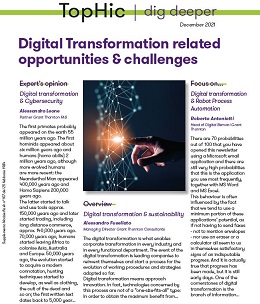-
Transactional advisory services
Find out more about the transactional advisory services of Grant Thornton Financial Advisory Services
-
Valuations
Find out more about the valuations services of Grant Thornton Financial Advisory Services
-
Mergers and acquisitions
Find out more about the merger and acquisition services of Grant Thornton Financial Advisory Services
-
Forensic and investigation services
Find out more about the forensic and investigation services of Grant Thornton Financial Advisory Services
-
Recovery & reorganisation
Find out more about the Recovery & reorganisation services of Grant Thornton Financial Advisory Services
-
Business risk services
Find out more about the business risk services of Grant Thornton Financial Advisory Services
-
Business consulting
Find out more about the business consulting services of Grant Thornton Financial Advisory Services
-
Capital market
Capital market
-
Corporate and business tax
Find out more about our corporate and business tax services.
-
Direct international tax
Find out more about our direct international tax services.
-
Global mobility services
Find out more about our global mobility services.
-
Indirect international tax
Find out more about our indirect international tax services.
-
Transfer pricing
Find out more about our transfer pricing services.
-
Litigation
Our lawyers and accountants can manage all defense measures provided not only by the Italian law, but also by EU regulations and conventions
-
Family business
Find out more about our Family business services.
-
Legal
The client can be assisted in every need and with the same care both on important operations or disputes and on simple matters

-
Back office outsourcing
Find out more about our Back office outsourcing services
-
Business process outsourcing
Find out more about our business process outsourcing services.
-
Compilation of financial statements
Find out more about our compilation of financial statements services.
-
Tax compliance
Find out more about our tax compliance services.
-
Electronic invoicing
Find out more about our electronic invoicing services
-
Electronic storage
Electronic storage is an archiving procedure that guarantees the legal validity of a digitally stored electronic document
-
Revaluation of corporate assets
Find out your civil and fiscal revaluation of tangible, intangible and financial assets
-
Payroll
Complete and customized payroll service, integrated with digital solutions and compliant with Italian and international regulations.
-
Labor consultancy
We help Italian and international companies manage all aspects of their workforce.
-
HR & Payroll Advisory Services
We review contracts, payroll, and risks for extraordinary transactions and we assess tax, labor, and safety risks in outsourcing contracts.
-
Extended services
We provide integrated digital tools to simplify HR management.
-
HR Infinity Portal
The HR Infinity Portal is Zucchetti’s platform designed to centralize communication between the company and its employees.
-
Cybersecurity
GT Digital helps clients structure information security management internal functions, also through partially or totally outsourced functions
-
Agile and Programme Management
GT Digital provides support in the adoption and implementation of different portfolio management
-
Robotic Process Automation
Our “BOT Farm” can rely on digital workers able to help clients in routine activities, allowing employees to deal with more added-value activities
-
Data strategy and management
GT Digital can support clients in seizing the opportunities offered by Big Data, from the definition of strategies to the implementation of systems
-
Enterprise Resource Planning
We support clients in selecting the most appropriate ERP System according to their specific needs, helping them also understand licensing models
-
IT strategy
GT Digital supports clients in making strategic choices, identifying innovation opportunities, comparing themselves with competitors
-
IT service management
We can support with software selection and with the implementation of dedicated tools for the management of ICT processes
-
DORA and NIS 2
The entry into force of the DORA Regulation and NIS2 represents a major step towards the creation of a harmonised regulatory framework
The digital transformation is what enables corporate transformation in every industry and in every functional department. The event of the digital transformation is leading companies to reinvent themselves and start a process for the evolution of working procedures and strategies adopted so far.
Digital transformation means approach innovation. In fact, technologies concerned by this process are not of a “one-size-fits-all” type: In order to obtain the maximum benefit from their application/implementation, companies must, at the same time, introduce an evolution of processes and of their corporate culture. In this deep changing context, the presence and the support of experts having specific skills in this field is crucial in order to be able to exploit the potential of this transformation in the best way possible.
Companies that first decide to move in this direction can benefit from the so-called first-mover advantage, which can bring them in a few years to become industry leaders and leaders in the market segment in this evolution process.
When any change must be faced, some cornerstones should be set during the transition. In the case of digital transformation, the pillars to be observed and maintained are customer retention and relationships with suppliers/partners who collaborate with the company in the supply chain management.
Technologies involved in the digital transformation process are different and each of them can be used differently depending on the industry in which the company operates and on the business model adopted.
However, there is one thing that is common for all digital transformation processes: big data and data analytics. The collection and analysis of data through tools that turn them into useful information opens up new opportunities for companies. This kind of analysis allows them to connect and interpret destructured data to support managers in the decision-making process and in the evaluation of new business strategies in real time, making their activity faster, more flexible and more efficient.
At the same time, since the tools used for the collection, analysis and smart interpretation of data are physical devices that can receive and transmit data through the Internet (IoT technologies), there is a higher need to protect links, tools and data from the increasing threats coming from the IT world. Cybersecurity therefore becomes a crucial element of the digital transformation: investing in technologies and create dedicated cybersecurity teams is essential to implement a successful strategy in any business.
Sustainability
Sustainability is constantly evolving. The challenges for a responsible interaction with the environment, i.e., an interaction that could maintain a high environmental quality in the long run, are constantly changing and become more and more complex. A digital transformation process and the subsequent adoption and integration of new technologies in the business allow production processes to become more functional, more sustainable ad less polluting over time.
The application of technologies such as Advanced analytics, IoT, AI, Big Data and Blockchain not only generates value for businesses, but it also contributes to the creation of smart ecosystems. It was demonstrated that investing in sustainability implies an improvement in performances, not only in financial terms, but also from a process and corporate culture perspective. Adopting a Sustainability Strategy that integrates the use and implementation of enabling technologies, such as those mentioned above, allows speeding up the achievement of such objectives, maximising the expected result.
There are many examples that show how the integration of these technologies in the Sustainability Strategy generates advantages for a business and for the in which it operates. Synergies between sustainability and digital technologies become increasingly stronger and more complex, involving an increasing number of industries. Below are some examples.
- Use of AI for the reduction of air pollution levels and for the improvement of energy efficiency within structures.
- Smart Agriculture - Smart Agriculture means using available technologies to create a more rational, efficient and sustainable, minimizing waste and optimizing the use of resources. Smart Agriculture is already a highly growing sector and it is expected to reduce the use of pesticides by 85% and to increase crop (and turnover) by even 20%.
- The application of technologies such as AI, advanced analytics and IoT in this sector allows obtaining automated guided drones and tractors that enable the application of a “precision agriculture”. The pinpoint monitoring granted by such technologies allow reducing, in terms of quantity and cost, raw materials used. Moreover, these tools allow performing activities such as: monitor crops health, identify too-much or too-little irrigated land, and apply pesticides only where it is needed.Smart Agriculture can be an opportunity to save costs for companies and it can contribute to the creation of a circle market that is expected to be worth approximately 127 billion dollars in 2030.
- Smart cities - Smart City is an idea of urban reality that manages resources in a smart way, aiming to economic sustainability and energy self-sufficiency, in order to improve the quality of life of its inhabitants. The purpose is that of rendering infrastructure “smart”, by connecting them with each other and endowing Administrations with instruments that can simplify decision making processes. The use of technologies as AI and IoT can allow integrating city planning, services and infrastructures, improving citizens’ lives. A smart use of data, which is possible thanks to the abovementioned technologies, allows monitoring, analysing and developing smart actions, such as: design of low energy districts, smart management of public lighting, and implementation of a sustainable mobility system.
- Smart Supply Chain – The application of Industry 4.0 technologies (AI, IoT, blockchain, etc.) within the supply chain allows organizing, integrating, and regulating supply chains, turning from a fragmented model to an interconnected model, where companies operate jointly to provide a competitive output thanks to production processes managed in real time and most of all, thanks to the adoption of innovative business models. The implementation of AI within production processes grants visibility on the end-to-end logistic chain, allowing, among other things, to monitor costs, reduce waste and optimize consumption.
- Monitoring the observation of employees’ and human beings’ rights – By using AI and IoT, it is possible to monitor working stations of people working in a supply chain (e.g., assembly line). This allows the legislator to access data needed to assess the working conditions of human resources and ascertain that the employer complies with the law.

